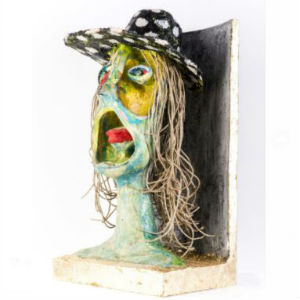When it comes to portraiture, paintings is the first medium to jump in mind.
However, in a new solo exhibition of sculpture, artist Gamal Abdel Nasser takes the viewer on a joyful adventure, displaying his unique way of capturing funny and odd human features.
The exhibition was inaugurated 28 January at Cairo's Zamalek Art Gallery and runs until 20 February.

(Photo: courtesy of the Zamalek Art Gallery)
The sculptures, made of wood and mixed materials, are a unique example of a post-modernist vision.
The amazing bright colors and shapes of the exhibited faces reveal peculiar human moments; laughing, screaming, mocking or meditating.
Touring the main hall of the gallery, I instantly felt the joy, astonishment and sarcastic loud laughs.

(Photo: courtesy of the Zamalek Art Gallery)
Born in 1957, Abdel Nasser graduated from the Faculty of Fine Arts' Sculpture Department in 1981 and was a student of the great late sculptor Sobhi Gerguis, who passed away in 2013. As a student, Abdel Nasser rebelled against repetition and classic forms taught then in the department.
The biggest shift in the artist’s career took place in 1991 when he attained a six-month scholarship to Switzerland. It was there that he discovered the beauty of colours, the scent of freedom, and learned using scrap, like remains of bicycles and chairs.
One of his unique experiences was in 1995 when he participated in the Yorkshire African Sculpture Festival, organised by England's Delifina Studio Gallery, where learned from participating African sculptors how to merge stone with wood.

(Photo: courtesy of the Zamalek Art Gallery)
After graduation, Abdel Nasser held a number of solo exhibitions, the most notable of which were in 1983 at the Spanish Cultural Centre in Cairo, in 1990 at the Centre of Arts (Akhnaton Gallery), in 1991 at the Arles Heim Hause, Basel-Switzerland, the Leistal Gallery, in 1992 at the Egyptian Academy in Rome, and in 1999 in the Venice Biennale, Town House Gallery. The artist held three solo exhibitions at Zamalek Art Gallery, in 2009, 2011 and 2014.
Unlike other sculptors who are influenced by ancient Egyptian sculpture, which is very static, Nasser’s sculptures stand out as unique and poignant.
He considers the frenzied movement of his sculptures as a sign of rebellion against classic sculpture.

(Photo: courtesy of the Zamalek Art Gallery)
Cheerful movement is one of the artist’s strongest characteristics. The wooden swing hanged from the ceiling, the movement of a clown, or a creature with the face of a reptile, holding ithin long arms up high, are very remarkable. His figures are funny and sarcastic and yet shocking and painful. He has never abided by the usual shape of human figures.
In this exhibition, heads are central; they take almost the whole human figure. One of the amazing pieces sized 35x64x35 features a huge head of a human, with tiny legs in the bottom.

(Photo: courtesy of the Zamalek Art Gallery)
In light green and yellow, engraved wrinkles and thick lips give the impression of a unique African appearance. The influence of the African school of sculpture is easily observed.
Another figure 27x65x30 is portrait of a human; it could be a man or a woman, coloured with degrees of orange and green.
The look of the wide eyes is very unique; they are cheerful and yet sad, calling for human compassion and yet proudly independent.

(Photo: courtesy of the Zamalek Art Gallery)
Nothing of the exhibit bears a direct political reference. However, the viewer can trace the figures’ rebellious spirit. An exception to this removal from direct politics was his last exhibition, also held at Zamalek Gallery, featuring a president carried on a moving throne. The throne is lifted on two wheels, made in a reference to vast change in Egypt’s political atmosphere in the aftermath of the 25 of January Revolution.
In the current exhibition, rebellion also depicted in a few pieces. One piece features a face of a screaming young woman; her mouth is open wide, her tongue hanging in the middle of her hollow mouth, while appalled eyes together with her pale hair and black hat proclaim a worldly tragedy. She doesn’t belong to a certain culture, though her screams are easily heard.

(Photo: courtesy of the Zamalek Art Gallery)
For more arts and culture news and updates, follow Ahram Online Arts and Culture on Twitter at @AhramOnlineArts and on Facebook at Ahram Online: Arts & Culture
Short link: